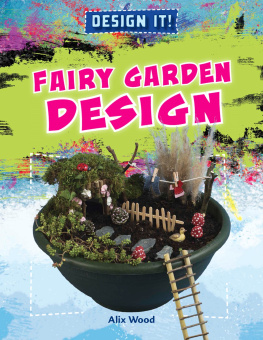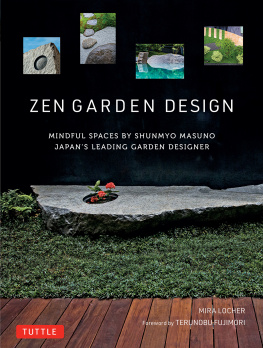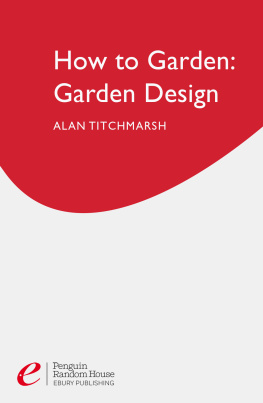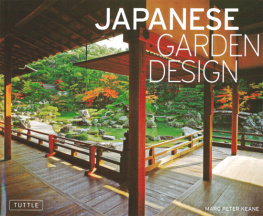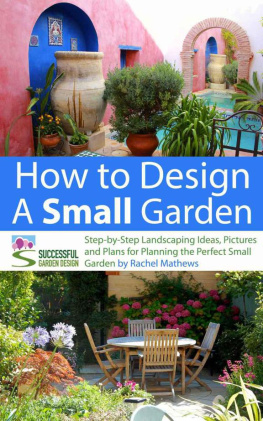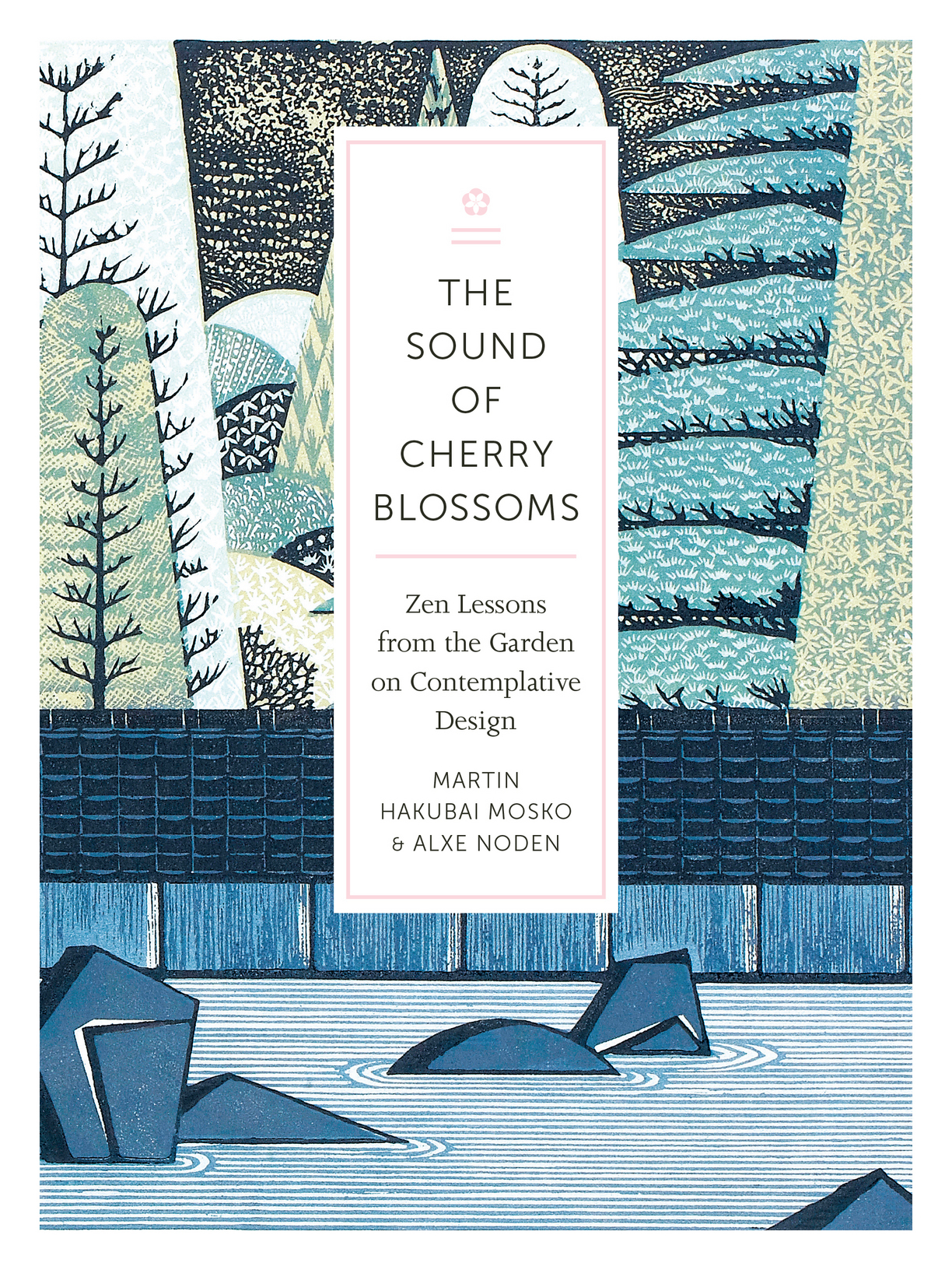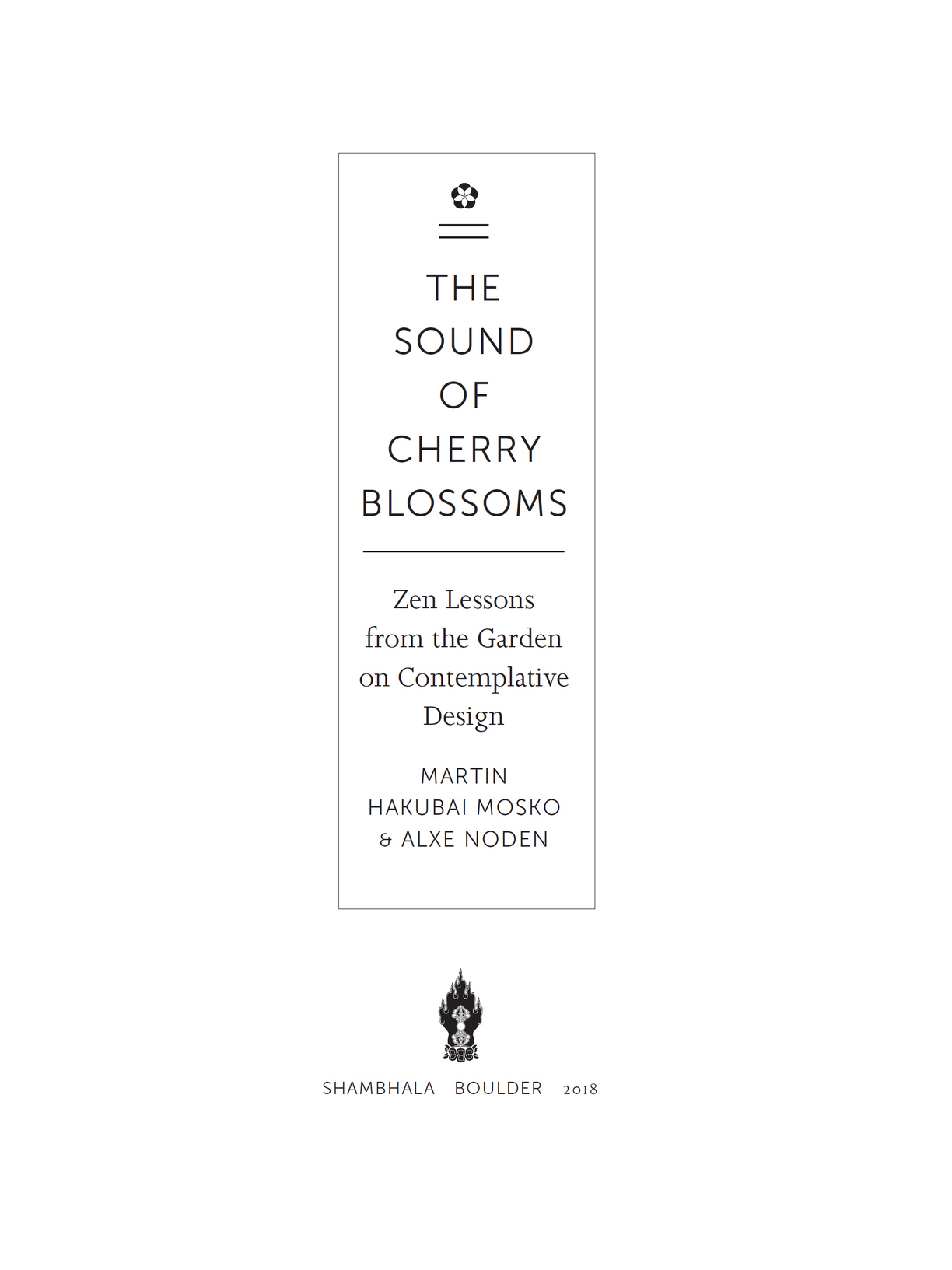Shambhala Publications, Inc.
All rights reserved. No part of this book may be reproduced in any form or by any means, electronic or mechanical, including photocopying, recording, or by any information storage and retrieval system, without permission in writing from the publisher.
Names: Mosko, Martin Hakubai, author. | Noden, Alxe, author.
Title: The sound of cherry blossoms: Zen lessons from the garden on contemplative design / Martin Mosko and Alxe Noden.
Description: First edition. | Boulder: Shambhala, 2018.
Identifiers: LCCN 2017019280 | ISBN 9781611804539 (pbk.: alk. paper)
Subjects: LCSH : GardensDesign. | Zen Buddhism.
THE BEGINNING
In the gap between thoughts, we find freedom and possibility. Its a long way from that first glimpse to full realization, and meanwhile we need a vision of the future so powerful it can pull us out of the morass of our habitual patterns, delusions, insecurities, and distractions. Implementing that vision is the subject of design.
I have been designing, building, and caring for gardens for nearly fifty years. From the beginning, my design work has been joined with my spiritual life and practice. Recognizing this interconnection, I call what I do contemplative or non-dual design. What does this mean? While I use traditional principles of landscape architecture in my work, I also use methods that create gardens with spirit. This begins with understanding the true nature of what Im doing: while to some people a garden may be just a space with some plants thrown in, to me a garden is a refuge, a place of reverence. It is a place where spirit meets daily life, and in which there is the possibility of awakening and insight.
I have seen how a garden can affect peoples lives in ways both ordinary and profound. A garden potentially has enormous powernot a masculine power of rockets and buildings but a feminine power of beckoning and inviting. It has the power of manifest wisdom. When a garden is able to live up to its true potential, it is the expression of spirit; it is the vital link between Heaven and Earth.
The goal of contemplative design is to establish this vital link. Using Zen principles, and with the same information and materials as in traditional design, we create transformative environments. Our intention is to bring uplift and lightness to our work, and create an environment where realization is possible. When applied mindfully, these same principles can connect to the spiritual aspects of our lives and allow us to be alive in the present moment.
This book describes my process of contemplative design, from creating the vision for a garden to all the considerations that go into the planning, construction, and maintenance of the space. Here, I dont select plants or plot cookie-cutter landscape designs. Instead, my aim is to present the art and spirit of design.
The work of contemplative design begins with an awareness of our thoughts and feelings, our design goals, and the world around us. To create a true garden, we have to see clearly, without judgment, exactly what is going on in ourselves and the space we are working in. We have to see how our lives are shaped and limited by habitual patternsboth positive and negativebefore we can understand how to generate patterns that bring about peace, health, and well-being. When we can work with sincerity, patience, and discipline, we will have the capacity to create a garden (and a life) where we can be fully alive and aware of our connections to one another and our natural environment.
Design work in any field is about intentional living. We repeatedly return to awareness of our thoughts, our feelings, and the processes of our cognition. Only by doing so are we able to see and analyze how our habitual patterns manifest physically, bringing either benefit or harm to our environment, our institutions, our culture, and ourselves. When we understand how to join Heaven and Earth in the garden, we understand how to transform our lives, work, and environment into a field of dynamic balance and harmony. Design is the template. It teaches us how to live a meaningful and happy life and how to integrate our spiritual lives and our daily lives.
The secret to happiness is to unite the spiritual with the ordinary, to join Heaven and Earth. My own path has been to create gardens. I was introduced to the link between spiritual work and gardening in 1965 when I joined the Peace Corps and was sent to India. While there I went to the ashram of Shri Anandamurti (Prabhat Ranjan Sarkar), an Indian philosopher and yogi who initiated me into the practice of basic meditation: sitting with an upright spine and using a mantra as I followed my breath as it flowed in and out. When I breathed in, I listened for the sound hum and when I breathed out, I listened for the sound so. I practiced assiduously on my own when I was back in the small village where I lived. Though the Peace Corps had trained me in poultry husbandry, they emphasized that I should try to find out what the community, which was divided into castes, subcastes, and three religions, wanted to do. In my village, what they wanted was a public park. So there I was, meditating in the morning and the evening and figuring out how to design and build a garden. From that time forward my spiritual life and my work life have evolved together, like a pair of aging hands.
Later, my path was very much influenced by two of my teachers. The first was the venerable Chgyam Trungpa Rinpoche. I met him in 1973 at his center in Vermont. He was a Tibetan teacher, a lama who had given up his monks robes. When he moved to Boulder in 1974, I followed him. There I went to see him for an interview and asked him if I could be the shrine keeper. He told me no. Instead, he said, you should stabilize your living situation and build Japanese-style gardens at an American scale. This has been my practice ever since.
The second teacher who strongly influenced my garden design sensibility was Kobun Roshi, a Japanese Zen teacher. He and Trungpa Rinpoche were close, and I had the good fortune of studying extensively with both of them. Rinpoche was always my teacher, but Kobun was not only my teacher but as close to me as my brother. Kobun ordained me and sent me to Japan to study Zen with his own elder brother, Tenzan Keibun, and to study gardening with a garden master. While in Japan, Keibun ordained me and became my Zen master. It is through him that I inherit the Soto Zen lineage.
What I have learned is that spirit lives in the ordinary stuff of life. We cant look to our teachers and think that their understanding is unattainable for us because we do not live in caves in India or Tibet, or in a monastery. For most of us, we have to find our happiness in the activities of secular life. This is our opportunity. This is also where the subject of design arisesthe instant we wake up and realize that how we live is who we are we are on the path of contemplative design. Studying design is both learning and training. It is good in the beginning, good in the middle, and good at the end. This is an enjoyable pursuit. Let us cultivate the field of design.


